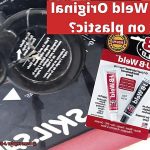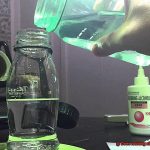Have you ever found yourself in a sticky situation with epoxy? Maybe you were trying to fix a broken vase or create a piece of jewelry and accidentally got some on your skin or surface it wasn’t supposed to be on. Removal can be an infuriating and sometimes fruitless process. But don’t panic, my friend, because there may be a secret weapon lurking in your bathroom cabinet – rubbing alcohol.
Rubbing alcohol is famous for its ability to clean and disinfect surfaces, but can it remove epoxy? The answer isn’t as straightforward as we’d like it to be. It depends on the type of epoxy, how long it has been on the surface, and the type and concentration of the rubbing alcohol. In this blog post, we’ll delve deeper into the specifics of epoxy removal using rubbing alcohol.
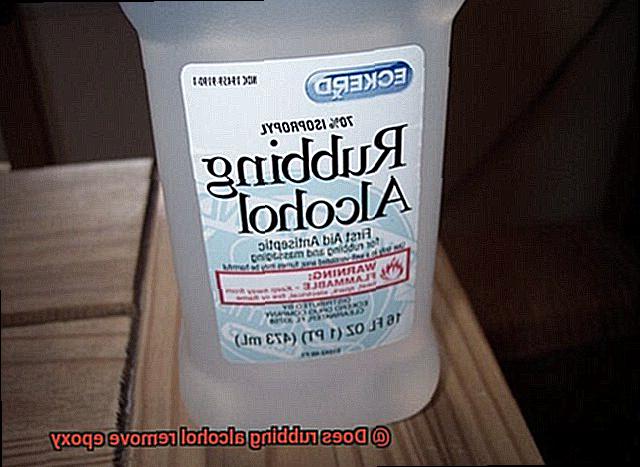
We’ll start by discussing the differences between epoxy types and their adhesive strength. Then we’ll explore the properties of rubbing alcohol and how they can potentially break down epoxy. We’ll also take a look at some alternatives to rubbing alcohol for removing epoxy. Finally, we’ll wrap up with some tips and tricks for successful epoxy removal that will leave you feeling like a pro.
Whether you’re an old hand at working with epoxy or just starting out, this post will provide valuable insight into the world of epoxy removal. So sit tight, grab yourself a cuppa, and let’s get started.
How Does Rubbing Alcohol Affect Epoxy?
Contents
- 1 How Does Rubbing Alcohol Affect Epoxy?
- 2 Factors to Consider When Using Rubbing Alcohol on Epoxy
- 3 The Pros and Cons of Using Rubbing Alcohol to Remove Epoxy
- 4 What Are the Alternatives to Removing Epoxy with Rubbing Alcohol?
- 5 How to Use Rubbing Alcohol Safely on Epoxy
- 6 Common Mistakes People Make When Removing Epoxy with Rubbing Alcohol
- 7 Tips for Successfully Removing Epoxy with Rubbing Alcohol
- 8 Conclusion
Epoxy is a widely used adhesive known for its exceptional bonding strength and durability. However, if not applied properly or exposed to certain chemicals, the bond can weaken or even break. Rubbing alcohol, which is commonly used for cleaning and disinfecting surfaces, contains isopropyl alcohol, a solvent that can dissolve some types of plastics and synthetic resins. When this solvent comes into contact with epoxy, it can break down the resin and weaken the bond.
The extent to which rubbing alcohol affects epoxy depends on the concentration of alcohol in the solution and the amount of time it is in contact with the adhesive. If the concentration is high and left on for an extended period, it can cause the epoxy to soften and eventually break down. On the other hand, if the concentration is low and only in contact with the adhesive for a short period, it may not have any noticeable effect.
It’s crucial to note that not all types of epoxy are affected by rubbing alcohol in the same way. Some types of epoxy are more resistant to solvents than others. Therefore, it’s vital to check the manufacturer’s recommendations before using rubbing alcohol or any other solvent on the adhesive.
Using rubbing alcohol to remove epoxy may seem like a quick fix, but it may not be the most effective solution. It can damage the surface it is bonded to and may require several attempts to remove all of the adhesive completely. It’s recommended to seek professional advice or use specialized products designed for removing adhesives safely and effectively.
Factors to Consider When Using Rubbing Alcohol on Epoxy
Removing epoxy can be a daunting task, but using rubbing alcohol can make the process easier. However, before you start, there are several essential factors that you need to consider. As an expert in this field, I have compiled some critical factors that you should keep in mind when attempting to remove epoxy with rubbing alcohol.
The concentration of rubbing alcohol is a crucial factor to consider. Higher concentrations of rubbing alcohol will be more effective at dissolving and removing epoxy, but they may also damage the surface. It’s always best to start with a lower concentration and gradually increase it if needed.
Another important factor is the type of epoxy you’re dealing with. Different types of epoxy have unique properties and characteristics that may require different methods for removal. Therefore, it’s essential to identify the type of epoxy before attempting to remove it.
Moreover, the surface that the epoxy is applied to is crucial to consider when using rubbing alcohol. Some surfaces may be more sensitive to the effects of rubbing alcohol than others, and may require more gentle treatment to avoid damage or discoloration.
Additionally, safety must always come first. Rubbing alcohol is highly flammable, so ensure that you are working in a well-ventilated area and taking appropriate precautions to avoid any potential hazards.
The Pros and Cons of Using Rubbing Alcohol to Remove Epoxy
First, let’s discuss the pros. One of the most significant benefits of using rubbing alcohol is its easy availability and affordability. You can find rubbing alcohol in almost any grocery store or pharmacy, and it is relatively inexpensive compared to other epoxy removal products. Plus, rubbing alcohol is a mild solvent, which means it is less likely to damage surfaces or cause harm to the user.
However, there are also some cons to consider when using rubbing alcohol for epoxy removal. Firstly, rubbing alcohol may not be strong enough to dissolve certain types of epoxy adhesives. This means that even after applying rubbing alcohol, some traces of epoxy may still remain on the surface. Additionally, removing epoxy with rubbing alcohol may require a significant amount of time and effort, especially for larger or more stubborn stains.
Another potential downside of using rubbing alcohol for removing epoxy is the risk of damaging certain surfaces. Rubbing alcohol may be too harsh for delicate or porous materials such as wood or fabric, causing them to warp or discolor. It is crucial to test the rubbing alcohol on a small, inconspicuous area before attempting to remove epoxy from a larger surface.
To summarize, here are some key points to consider:
Pros:
- Available and affordable
- Mild solvent that is less likely to cause harm
Cons:
- May not be strong enough for certain types of epoxy adhesives
- Requires time and effort for satisfactory results
- Risk of damaging some surfaces
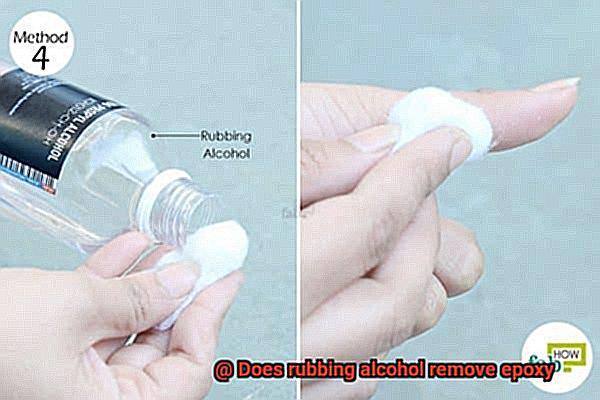
So, what’s the verdict? While rubbing alcohol can be a useful tool for removing certain types of adhesives, its effectiveness for removing epoxy may vary depending on the type of adhesive and the surface it is applied to. It is essential to weigh the pros and cons before deciding whether or not to use rubbing alcohol for epoxy removal and to take precautions to avoid damaging surfaces or causing harm to oneself.
What Are the Alternatives to Removing Epoxy with Rubbing Alcohol?
Fear not, for there are a variety of alternative methods that may be more effective depending on the type of epoxy and surface it’s on. As an expert in the field, I’ve compiled a list of some of the most viable options for tackling stubborn epoxy.
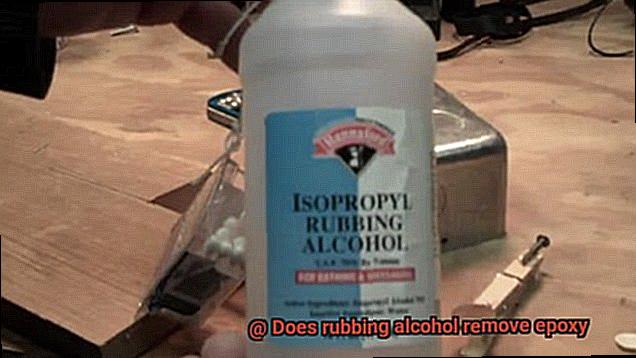
Firstly, applying heat is a great way to make epoxy more malleable. Whether you use a hairdryer, heat gun, or hot water soak, a little bit of warmth can go a long way in softening the adhesive for easy removal. This option is particularly useful for small areas or thin layers of epoxy.
Secondly, solvents such as acetone, mineral spirits, or paint thinner can break down the adhesive. However, be cautious as these solvents may damage certain surfaces. Always test a small area first and wear protective gear when using any chemical.
Thirdly, when dealing with thick or stubborn layers of epoxy, mechanical removal may be your best bet. This method requires some elbow grease but can be effective through scraping or sanding. Just be careful not to damage the surface underneath.
Lastly, specialized chemical removers are available specifically for epoxy removal. These products should be used with caution and according to the manufacturer’s instructions.
How to Use Rubbing Alcohol Safely on Epoxy
Using rubbing alcohol on epoxy can be a great way to remove stubborn residue, but it’s important to take the necessary safety precautions to avoid any damage or harm. In this article, we’ll explore five sub-sections for using rubbing alcohol safely on epoxy.
Safety Gear

Before you begin, make sure you have all the necessary safety gear. Wear protective gloves and goggles to prevent any contact with the skin or eyes. Additionally, ensure that the area is well-ventilated to avoid inhaling any fumes.
Test a Small Area First
It’s always best to test a small, inconspicuous area of the surface before applying rubbing alcohol to the entire area. This will help determine if there are any negative effects on the surface, such as discoloration or damage. If there are no negative effects, then it is safe to proceed with using rubbing alcohol on the epoxy.
Use a High Concentration of Rubbing Alcohol
For maximum effectiveness, use rubbing alcohol with a concentration of 90% or higher. Lower concentrations may not be effective in removing the epoxy and may cause damage to the surface.
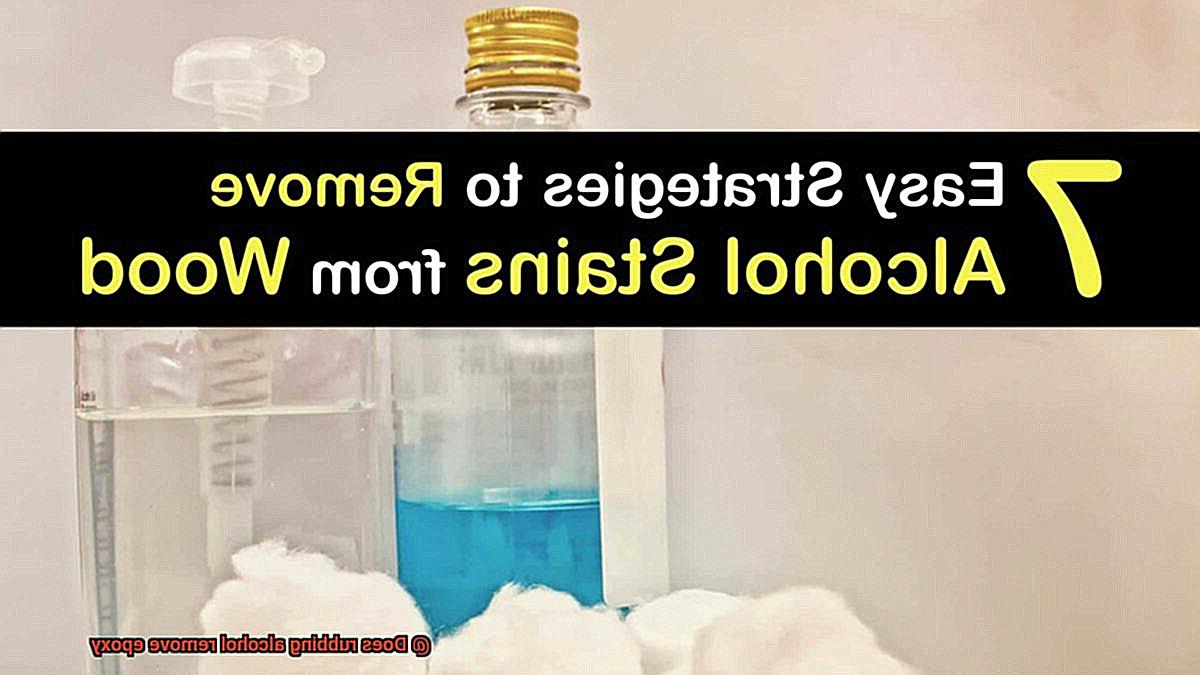
Apply Gentle Pressure
When applying rubbing alcohol, use a soft cloth or sponge and apply gentle pressure. Rubbing too hard can cause damage to the surface. It’s also important to avoid using abrasive materials or tools when applying rubbing alcohol as this can also cause damage.
Thoroughly Rinse with Water
After using rubbing alcohol to remove the epoxy, thoroughly rinse the surface with water to remove any remaining residue and prevent any potential damage from prolonged exposure to the solvent.
It’s important to note that rubbing alcohol may not be effective for removing all types of epoxy. Some industrial-strength epoxies may require specialized solvents or cleaners for removal. Always check with the manufacturer or consult a professional before attempting to remove any stubborn epoxy residue.
Lastly, it’s important to properly dispose of any used materials. Do not pour rubbing alcohol down the drain as it can be harmful to the environment. Instead, dispose of it in a sealed container and take it to a hazardous waste disposal facility.
Common Mistakes People Make When Removing Epoxy with Rubbing Alcohol
Removing epoxy with rubbing alcohol can be a tricky process, but with the right knowledge, you can avoid common mistakes and get the job done right. As an expert on this topic, I’m here to share some tips and tricks to help you successfully remove epoxy without damaging surfaces or putting yourself at risk.
One of the most common mistakes people make when attempting to remove epoxy with rubbing alcohol is not using enough of it. Rubbing alcohol needs to be applied liberally for it to have the desired effect on the epoxy. Using too little alcohol may not dissolve the epoxy completely, leaving behind a sticky residue that’s challenging to clean up.
Another mistake people often make is not allowing enough time for the rubbing alcohol to work its magic. Patience is critical when it comes to removing epoxy with rubbing alcohol. The alcohol needs time to dissolve the epoxy fully, so rushing the process can lead to damaged surfaces or incomplete removal of the epoxy.
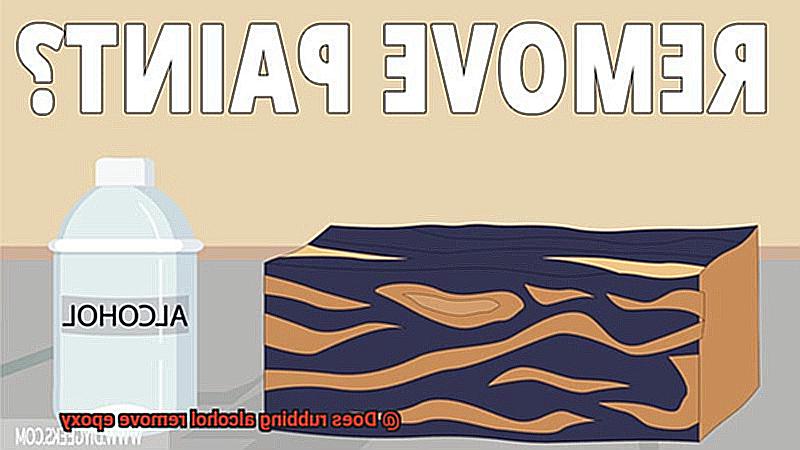
Using the wrong type of rubbing alcohol is also a common mistake. It’s crucial to use 90% or higher concentration isopropyl alcohol, as lower percentages may not be strong enough to break down the epoxy. Additionally, some rubbing alcohols contain additives that can damage certain surfaces, so it’s essential to read the label and ensure that it’s safe for use on the surface you’re working with.
Lastly, not wearing protective gear can be a grave mistake when removing epoxy with rubbing alcohol. Rubbing alcohol is harmful if ingested or inhaled, so it’s vital to wear gloves and a mask while using it. Working in a poorly ventilated area may cause health risks, so taking breaks and getting fresh air is necessary.
Tips for Successfully Removing Epoxy with Rubbing Alcohol
Epoxy can be an incredibly strong adhesive, making it challenging to remove from surfaces. However, rubbing alcohol has proven to be an effective solution for breaking down epoxy and removing it. Here are five tips for successfully removing epoxy with rubbing alcohol.

Use High-Concentration Isopropyl Alcohol
When choosing rubbing alcohol for removing epoxy, it’s crucial to select a high-concentration isopropyl alcohol. A concentration of at least 90% isopropyl alcohol will make the solution more effective in breaking down the epoxy.
Prepare the Surface
Before applying rubbing alcohol, prepare the surface by scraping off any excess epoxy using a plastic scraper or putty knife. You can also use a heat gun or hairdryer to soften the epoxy and make it easier to remove.
Apply Rubbing Alcohol Generously
Once the surface is prepared, apply rubbing alcohol generously on the affected area using a clean cloth or cotton ball. Allow the alcohol to soak into the epoxy for about ten minutes before attempting to remove it.
Use a Plastic Scraper or Putty Knife
After letting the alcohol sit for ten minutes, use a plastic scraper or putty knife to gently scrape off the softened epoxy. Be sure to work slowly and carefully to avoid damaging the surface underneath.
Repeat If Necessary
If there are any stubborn spots where the epoxy is still clinging on, repeat the process until all traces of epoxy have been removed. Avoid using metal scrapers or blades as they can scratch or damage the surface you are trying to clean.
Remember to wear gloves and work in a well-ventilated area when using rubbing alcohol. If you notice any damage or discoloration on the test area, it may be best to try a different method for removing the epoxy.
IzmKeM1ovAs” >
Conclusion
To sum up, removing epoxy is a daunting task that can take up a lot of your time. However, rubbing alcohol can be the secret weapon you need to make it easier. It’s important to note that not all types of epoxy are affected by rubbing alcohol in the same way. Therefore, factors such as concentration, type of epoxy, and surface material must be taken into account before attempting to remove any adhesive.
Rubbing alcohol has its pros and cons for removing epoxy. However, alternative methods such as using heat or solvents may be more effective depending on the situation at hand.
Safety should always come first when using rubbing alcohol to remove epoxy. Protective gear must be worn, a small area should be tested first, high concentration of rubbing alcohol should be used, gentle pressure applied, and thorough rinsing with water done after.
Common mistakes people make when removing epoxy with rubbing alcohol include not using enough of it, not allowing enough time for it to work effectively, using the wrong type of rubbing alcohol, and not wearing protective gear.


